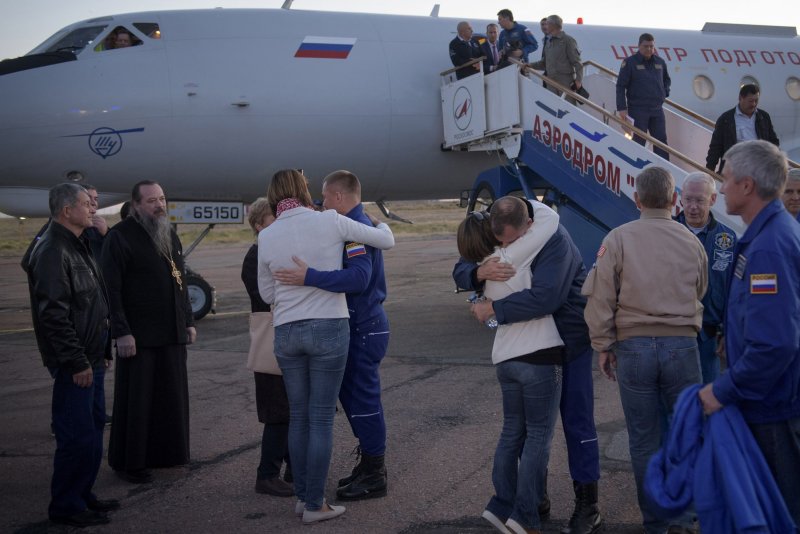1 of 10 | Cosmonaut Alexey Ovchinin of Roscosmos, left, and astronaut Nick Hague of NASA, right. embrace their families Thursday after landing at the Krayniy Airport in Baikonur, Kazakhstan. Hague and Ovchinin were aided by rescue forces after they were forced to abort a spaceflight to the International Space Station. NASA Photo by Bill Ingalls/UPI |
License Photo
Oct. 11 (UPI) -- An American astronaut and Russian cosmonaut were forced to eject from an aborted launch to the International Space Station early Thursday and make an emergency landing.
NASA astronaut Nick Hague and Roscosmos cosmonaut Alexey Ovchinin were aboard the spacecraft when it launched at 4:40 a.m. EDT on a mission to the station. The duo blasted off from Kazakhstan's Baikonur Cosmodrome aboard the Russian Soyuz MS-10 spacecraft.
Moments after launch, the two were forced to eject from the spacecraft after they encountered trouble with a booster on the rocket.
"The Soyuz capsule returned to Earth via a ballistic descent, which is a sharper angle of landing compared to normal," NASA said.
"Search and rescue teams were deployed to the landing site."
The astronauts landed back on earth and were recovered "in good condition," NASA said. They were taken to the Gagarin Cosmonaut Training Center in Star City, outside Moscow.
"Roscosmos is forming a state commission to investigate today's Soyuz launch incident," the space agency said.
"I'm grateful that everyone is safe," NASA Administrator Jim Bridenstine said. "A thorough investigation into the cause of the incident will be conducted."
At one point, the crew reported they were weightless as the capsule began to fly free on its own. NASA commentator Brandi Dean said they would have been
subjected to higher gravity forces during the descent, but it is a "known mode of descent." The crew landed near the town of Dzhezkazgan, Kazakhstan, a staging point for re-entries from space.
The pair's space flight to the ISS was supposed to last for more than six hours.
This is the first Russian Soyuz booster launch mishap since an on-pad abort in 1983, which subjected the two crew members at the time to 17 times the force of gravity as the capsule pulled away from the exploding booster.
Re-entries from orbit have accounted for the only deaths in the history of Russian manned spaceflight. Cosmonaut Vladimir Komarov was killed in 1967 when a capsule malfunctioned and parachutes failed. In 1971, cosmonauts Vladislav Volkov, Georgi Dobrovoiski and Viktor Patsayev died when their craft depressurized on re-entry.
Typical crewed launches feature three passengers. Hague and Ovchinin were set to be just the second two-man crew to travel to the space station in recent years. Last year, NASA astronaut Jack Fischer and Russian cosmonaut Fyodor Yurchikhin shared a ride to ISS.
Thursday's early morning launch was broadcast live by NASA TV. Coverage began at 3:30 a.m.
Hague and Ovchinin were set to replace astronauts Drew Feustel and Ricky Arnold, as well as Russian cosmonaut Oleg Artemyev, who departed ISS and returned to Earth last week.
Upon arrival, the two new crew members were scheduled to be welcomed by Alexander Gerst of the European Space Agency, the expedition's commander, as well as Serena Aunon-Chancellor of NASA and Sergey Prokopyev of Roscosmos.
This is a developing story















